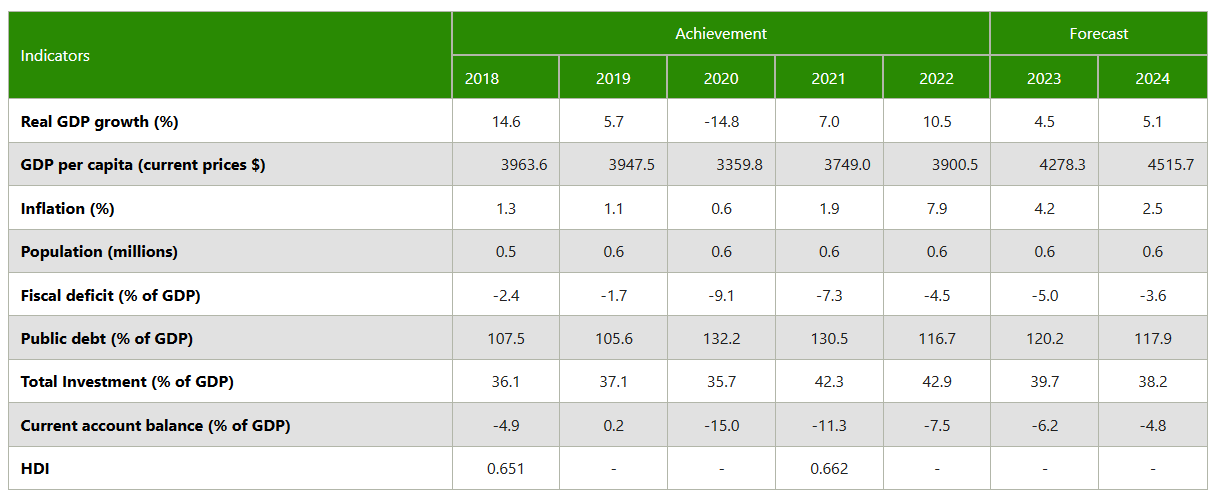
Macroeconomic Performance
Table 1: Overview of some macroeconomic indicators
 Guinea-Bissau recorded an average growth rate of 3.9 per cent over the last five years. Guinea-Bissau’s economy grew by 3.5 per cent in 2022, from 6.4 per cent in 2021. This was partly caused by a reduction in cashew exports. However, overall solid agriculture growth and increased private sector investment helped spur the growth in economic activity. The country recorded an inflation rate of 7.9 per cent in 2022, compared to 3.3 per cent in 2021. This inflation was mainly caused by the war in Ukraine, which triggered rising energy and food prices. The fiscal deficit fell slightly to 5.5 per cent of GDP in 2022 from 5.6 per cent in 2021. This was against the backdrop of higher-than-expected revenue mobilisation and wage overruns. Debt deteriorated to 79.5 per cent of GDP in 2022, from 78.9 per cent of GDP in 2021. Thus, the country faces a high risk of global and external debt distress. The current account deficit deteriorated further to 5.9 per cent of GDP from 0.8 per cent of GDP in 2021.
Guinea-Bissau recorded an average growth rate of 3.9 per cent over the last five years. Guinea-Bissau’s economy grew by 3.5 per cent in 2022, from 6.4 per cent in 2021. This was partly caused by a reduction in cashew exports. However, overall solid agriculture growth and increased private sector investment helped spur the growth in economic activity. The country recorded an inflation rate of 7.9 per cent in 2022, compared to 3.3 per cent in 2021. This inflation was mainly caused by the war in Ukraine, which triggered rising energy and food prices. The fiscal deficit fell slightly to 5.5 per cent of GDP in 2022 from 5.6 per cent in 2021. This was against the backdrop of higher-than-expected revenue mobilisation and wage overruns. Debt deteriorated to 79.5 per cent of GDP in 2022, from 78.9 per cent of GDP in 2021. Thus, the country faces a high risk of global and external debt distress. The current account deficit deteriorated further to 5.9 per cent of GDP from 0.8 per cent of GDP in 2021.
Outlook
Economic growth is expected to reach 4.5 per cent in 2023 and 4.9 per cent in 2024. This is expected to be driven by increased cashew exports and private-sector investment. Inflation is expected to fall slightly from 7.3 per cent in 2023 to 5.1 per cent in 2024. The fiscal deficit is expected to continue its downward trend, reaching 3.8 per cent of GDP in 2023 and 3.2 per cent of GDP in 2024. The debt-to-GDP ratio is expected to decline from 76.5 per cent in 2023 to 74.7 per cent in 2024. The current account deficit is projected to decline to 5.6 per cent of GDP in 2023 and 5.3 per cent of GDP in 2024.
Probable Headwinds
Guinea-Bissau is known to have a pronounced exposure to the vagaries of the climate. This affects agriculture adversely and a less-than-favourable weather pattern will dampen GDP growth. The country continues to face the negative impact of global inflationary trends. Unless this global inflationary trend subsides, the country will face higher financing costs both domestically and in regional financial markets. The risk of debt distress in the context of the risk of rising interest rates is a challenge to be taken seriously. Internal political tensions are threats for which structural solutions must be found.

